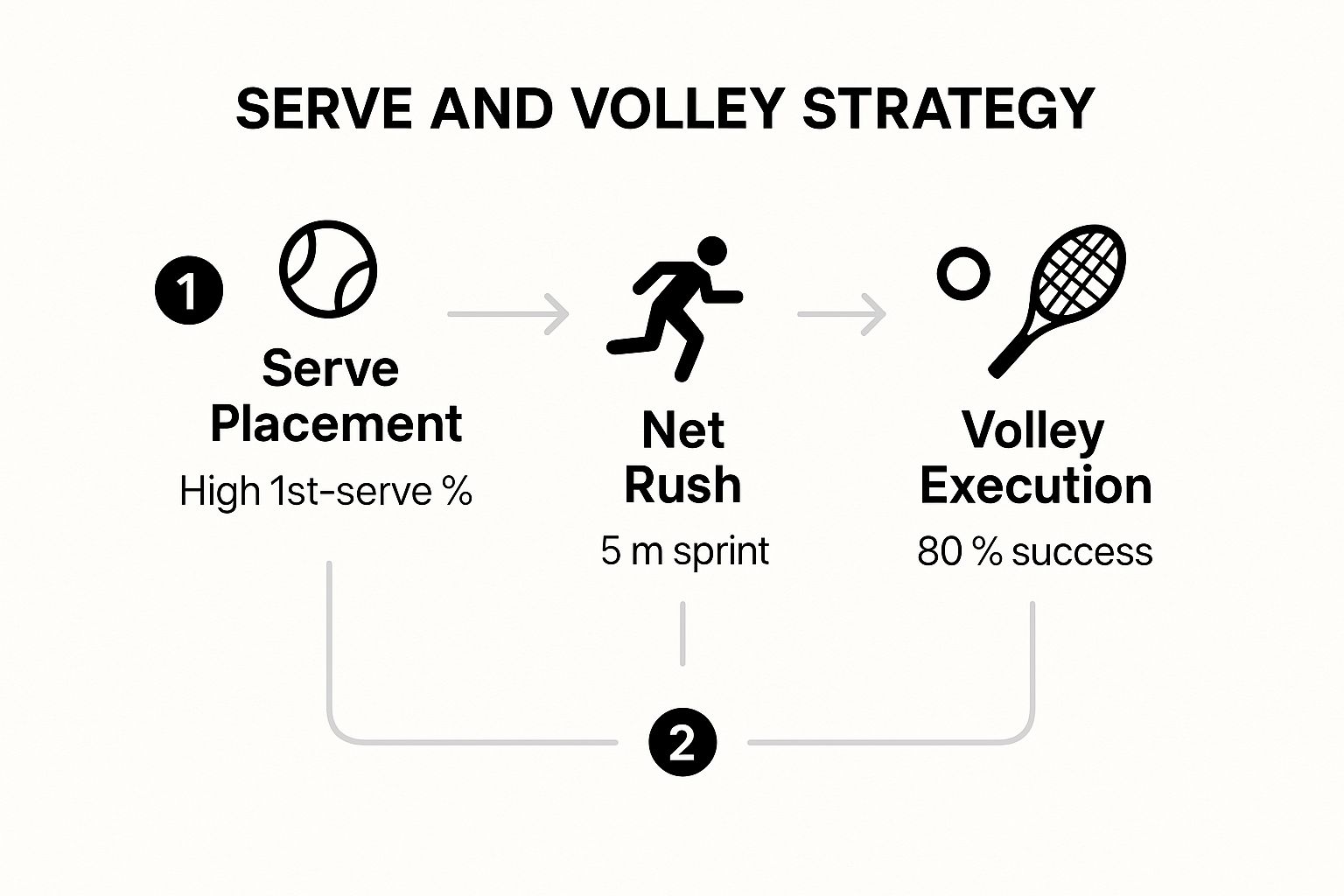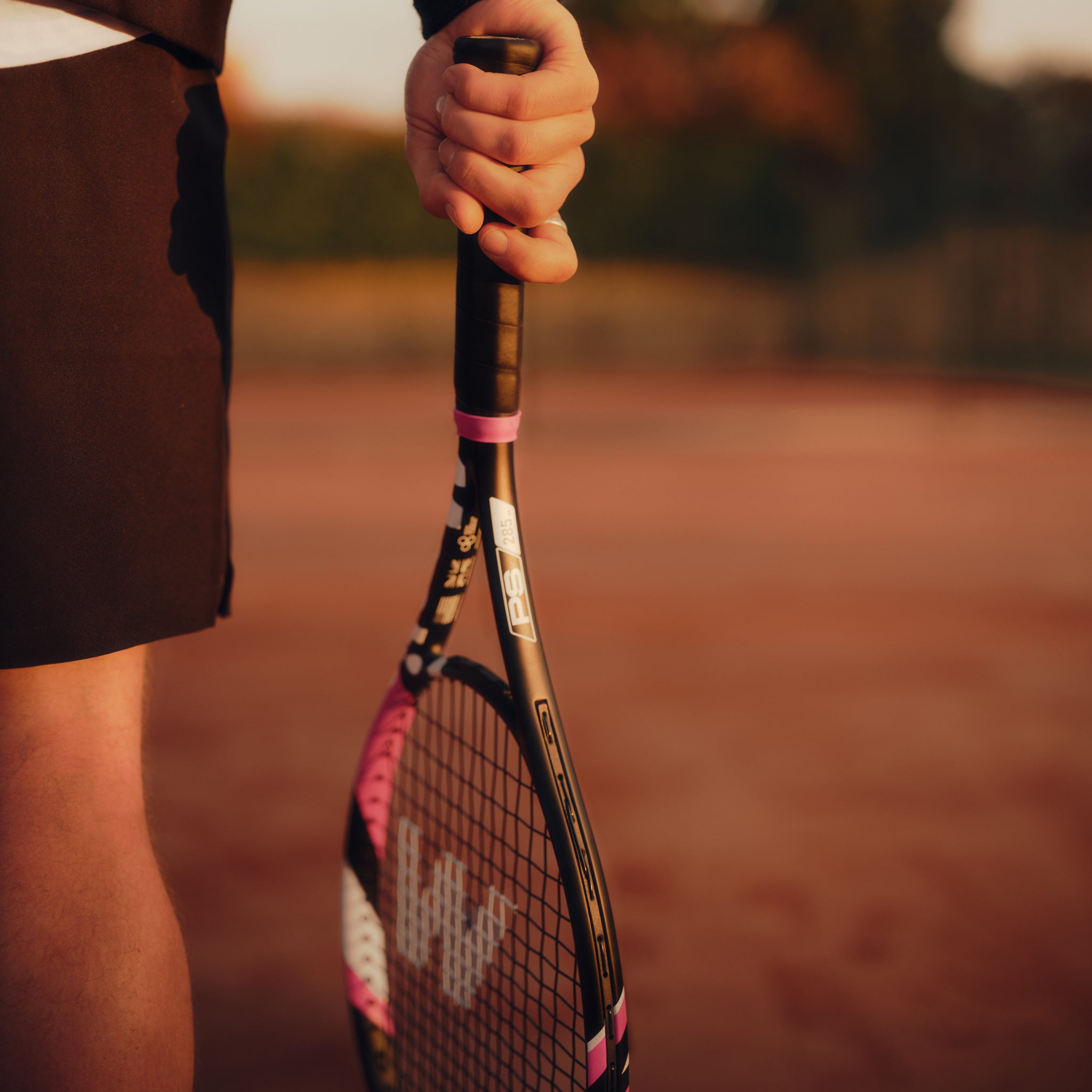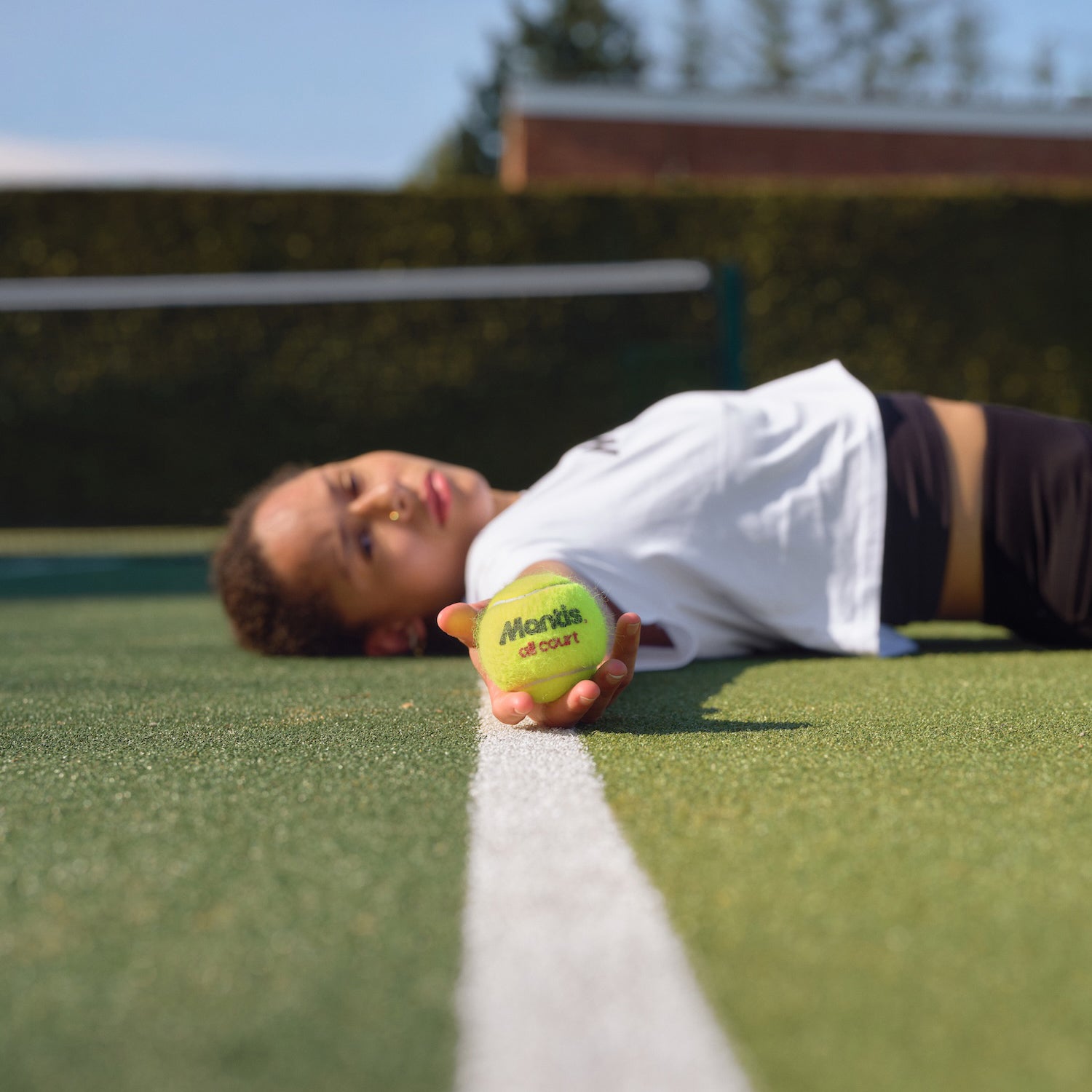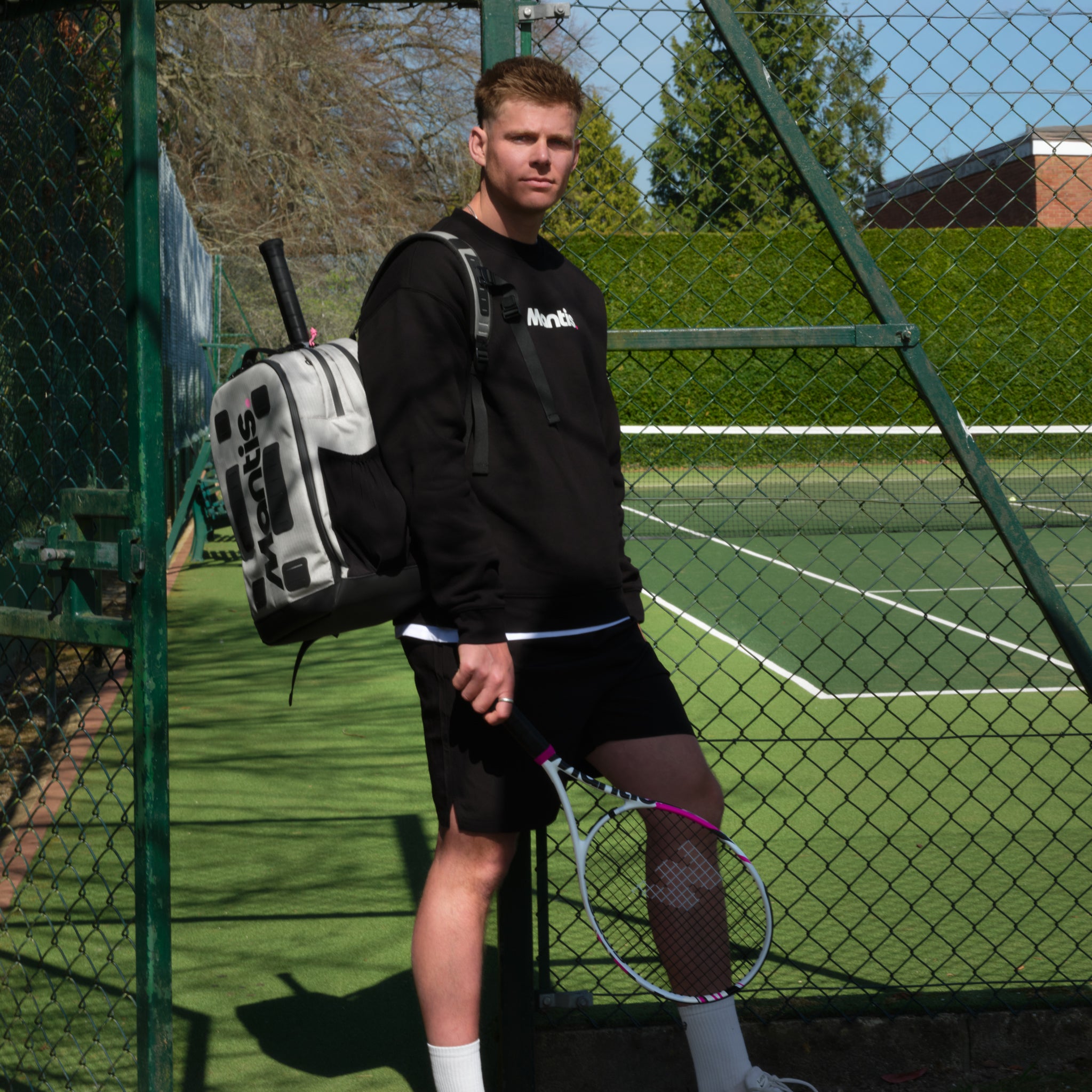
Welcome to the ultimate guide designed to elevate your game. If you've ever felt outmanoeuvred or strategically stuck in a doubles match, you're in the right place. Doubles isn't just singles with an extra player; it's a dynamic chess match on a tennis court, demanding communication, synchronised movement, and a shared tactical brain. Moving beyond basic groundstrokes and serves requires a deep understanding of court geometry and opponent psychology.
This article will dissect seven essential tennis doubles strategy frameworks that transform pairs from two individuals into a cohesive, formidable unit. We'll explore everything from aggressive net-rushing formations like the Serve and Volley or Australian Formation to disciplined defensive setups such as the Both-Back Formation. We will provide actionable insights for poaching, returning, and using lobs to counter any opponent. Whether you're a seasoned club player or new to competitive doubles, mastering these strategies will give you the organised approach needed to control points, create opportunities, and ultimately, secure more victories. Let's dive into the tactics that separate the good teams from the great ones.
1. Tennis Doubles Strategy 1: The Aggressive Serve and Volley Assault
The serve and volley is a classic, high-pressure tennis doubles strategy designed to dominate the net and shorten points. This offensive tactic involves the server immediately rushing forward after their serve, with the goal of intercepting the return with a decisive volley. When executed correctly, both partners are positioned at the net, creating an imposing wall that shrinks the court for the returners and forces them into making difficult, hurried passing shots.
This strategy was the cornerstone for legendary doubles pairs like John McEnroe and Peter Fleming, and later, "The Woodies" (Todd Woodbridge and Mark Woodforde). Their success demonstrates that a well-executed serve and volley can dismantle even the strongest baseline teams by denying them rhythm and time. The primary objective is to turn a neutral rally into an offensive advantage in a matter of seconds.
When to Use This Strategy
The serve and volley is most effective when:
- You have a high first-serve percentage. Consistency is more valuable than outright power.
- Your opponents struggle with returns under pressure or have weaker passing shots.
- You want to disrupt the rhythm of baseline-oriented opponents who prefer longer rallies.
- You and your partner are confident with your volleys and have quick reflexes at the net.
Key Insight: The success of this strategy hinges less on the power of the serve and more on its placement. A well-placed serve to the body or wide forces a predictable, weaker return, setting up an easier first volley for the advancing server.
How to Implement the Serve and Volley
The infographic below illustrates the essential sequence for a successful serve and volley assault, breaking it down into three critical phases.

As the diagram shows, achieving a high success rate relies on seamlessly linking a reliable serve, a quick transition, and a confident volley. To master this, focus on your forward movement, ensuring you perform a split-step just as the opponent makes contact with the ball. This provides the balance needed to react to any return. For a deeper dive into placement and consistency, you can explore detailed guides on tennis serve technique. Effective communication with your partner about who covers the middle is also crucial to avoid confusion and present a united front.
2. Australian Formation (I-Formation)
The Australian Formation, often called the "I-Formation," is a specialised tennis doubles strategy designed to disrupt the returner's target and neutralise their preferred cross-court return. In this setup, the server's partner kneels or stands in the centre of the court, directly in line with the server. This initial positioning obscures the server's motion and forces the returner to guess which side the net player will cover, creating indecision and often leading to a forced error or a weak reply.
This formation was famously popularised by Australian Davis Cup legends like John Newcombe and Tony Roche, and later mastered by the iconic Bryan brothers (Bob and Mike Bryan). Their success with this tactic highlights its power to break down the rhythm of even the most consistent returners. The primary goal is to take away the high-percentage cross-court return and force the opponent to attempt a much riskier down-the-line passing shot.
When to Use This Strategy
The Australian Formation is a high-reward tactic best deployed at critical moments:
- On crucial points like break points or game points to introduce maximum pressure.
- Against opponents who have a dominant cross-court return that you need to neutralise.
- When you want to break a negative pattern and inject unpredictability into the match.
- If you and your partner have excellent communication and pre-established signals.
Key Insight: The effectiveness of the I-Formation is rooted in deception. Its power comes not just from the positioning itself, but from the uncertainty it creates. Using it sparingly makes it far more potent than using it on every service point.
How to Implement the Australian Formation
Successful execution requires flawless communication and practiced movement. The server and partner must decide before the point which side each will cover after the serve. This is typically communicated through discreet hand signals from the net player, hidden behind their back.
For example, a signal with one finger might mean the net player moves to the deuce side, while two fingers means they move to the ad side. The server then knows to cover the opposite half of the court. The movement must be explosive and timed precisely as the returner makes contact with the ball. Constant practice is needed to synchronise these movements and ensure there are no gaps for the opponents to exploit, turning a clever gambit into a winning tennis doubles strategy.
3. One-Up, One-Back Formation
The one-up, one-back formation is the most common and versatile tennis doubles strategy, providing a balanced blend of offence and defence. This fundamental setup positions one player at the net, ready to attack, while the partner controls the point from the baseline. This creates a flexible structure that allows a team to cover the entire court, neutralising both aggressive volleys and powerful groundstrokes.
This formation is the default for most club-level, recreational, and even mixed doubles professional matches. Its prevalence is a testament to its effectiveness and adaptability. The core objective is to maintain a solid defensive foundation from the back of the court while simultaneously creating offensive pressure at the net, forcing opponents to hit precise shots to win the point.
When to Use This Strategy
The one-up, one-back formation is the go-to strategy for most doubles situations, particularly when:
- You are facing a team with varied playing styles.
- You want a balanced approach that can quickly adapt from defence to offence.
- Your team has complementary skills, for example, one strong baseliner and one aggressive net player.
- You are returning serve and need to stabilise the point before looking to advance.
Key Insight: The success of this formation relies on dynamic movement and communication. The baseline player is not just a defender; they are responsible for setting up the net player by hitting shots that force weak, high returns. The net player must be active, not static.
How to Implement the One-Up, One-Back Formation
Implementing this strategy effectively is about much more than just static positioning; it requires continuous adjustment and teamwork. The baseline player should focus on hitting deep, cross-court shots to push opponents back, which opens up angles and creates poaching opportunities for their partner.
For the net player, the key is to be an active threat. This means moving laterally along the net, feinting a poach to distract the returner, and communicating your intentions. The goal is to make the opposing team uncomfortable and force them into errors. Fluidly switching positions during a rally, where the baseliner advances after hitting an approach shot, is an advanced variation that can disrupt opponents and secure a winning position at the net.
4. Poaching Strategy
Poaching is an aggressive and opportunistic tennis doubles strategy where the net player moves across the court to intercept a shot intended for their partner. This surprise tactic is designed to finish the point with a decisive volley, catching the opponents off guard and creating immense pressure. A well-timed poach can disrupt the returning team's rhythm and completely shift the momentum of a game.
This high-risk, high-reward manoeuvre was famously executed by legends like John McEnroe and Martina Navratilova, and more recently perfected by specialists like Bob and Mike Bryan. Their ability to anticipate the return and move explosively made poaching a cornerstone of their doubles dominance. The goal is to shrink the court and force the returner to hit a perfect shot down the line under pressure.
When to Use This Strategy
Poaching is a powerful tool, best employed when:
- Your partner hits a strong, well-placed serve that is likely to elicit a weak or predictable cross-court return.
- The returner has a noticeable pattern or telegraphs their shots with their body language or racket preparation.
- You need to change the dynamic of the match, especially on crucial points like a break point.
- You and your partner have established clear communication signals for when a poach is planned.
Key Insight: Successful poaching is less about guessing and more about calculated anticipation. Watch the returner's hips and shoulders; where they point often reveals the intended direction of the ball, giving you the critical split-second advantage needed to move.
How to Implement the Poaching Strategy
To execute an effective poach, the net player must commit fully to the movement. The first step should be explosive and diagonal, aiming to cut the ball off before it crosses the net at its highest point. As the net player moves, the server must shift to cover the now-vacant side of the court, anticipating a potential lob or a shot down the alley.
Mastering this requires practice in explosive lateral movement and quick recovery footwork. Start by poaching on serves that naturally favour it, such as a serve directed at the opponent's body or out wide. Pre-match communication is essential; using simple hand signals behind your back allows your partner to know your intention to poach, so they can serve and position themselves accordingly. This coordinated effort transforms a risky move into a formidable, point-winning play.
5. Both-Back Defensive Formation
The both-back formation is a highly effective, consistency-focused tennis doubles strategy where both players start and play primarily from the baseline. This defensive posture is designed to counter aggressive net opponents, extend rallies, and patiently wait for an unforced error or an opportunity to transition to offence. Instead of forcing the action at the net, this approach prioritises court coverage and neutralising the opponent's power.
This strategy is often the default for clay-court specialists, who thrive on longer points and deep groundstrokes. It is also a smart tactical adjustment for teams facing dominant serve-and-volleyers or players with superior net skills. The core principle is to use depth and placement to move the net players around, forcing them into difficult volleys and creating openings for passing shots or lobs.
When to Use This Strategy
The both-back defensive formation is most effective when:
- You are facing a team with superior net skills and powerful volleys.
- Your team possesses strong, consistent groundstrokes and excels in baseline rallies.
- The opposing team is making a high number of unforced errors from the baseline.
- You need to break the rhythm of an aggressive, net-rushing team and reset the point.
Key Insight: The success of this strategy relies on patience and depth. Hitting deep, heavy groundstrokes consistently pushes the opposing net players back, neutralises their positional advantage, and often forces a weak reply that you can attack.
How to Implement the Both-Back Defensive Formation
Mastering this defensive setup requires discipline and a specific shot selection. The primary goal is to frustrate your opponents and turn their aggression against them.
To execute this effectively, both players must commit to staying back and building the point from the ground. Focus on hitting cross-court to the deepest parts of the court, as this provides the highest margin for error and the longest travel time. Use the lob not just as a last resort, but as an offensive weapon to push the net players off the net and regain neutral positioning. When an opponent hits a short ball, that is your cue for one player to move forward and seize the offensive opportunity, turning defence into a winning attack.
6. Return and Stay Strategy
The return and stay is a fundamental and reliable tennis doubles strategy centred on neutralising a powerful serve and constructing the point from the baseline. This tactic involves the returner focusing on hitting a deep, controlled return and then holding their position at the back of the court. Rather than going for a high-risk, aggressive winner, the primary goal is to get the ball back in play, deny the serving team an easy first volley, and build the rally on neutral or defensive terms.
This conservative approach is highly effective against teams that rely on a big first serve to gain an immediate advantage. By prioritising consistency, the returning team shifts the pressure back onto the servers to execute a difficult first shot, often from a low or awkward position. It is the go-to strategy for teams with strong groundstrokes and is frequently employed by professional pairs like Nikola Mektić and Mate Pavić, who use their baseline prowess to turn defensive situations into offensive opportunities.
When to Use This Strategy
The return and stay strategy is most effective when:
- You are facing a team with a formidable serve-and-volley player.
- The opponents have a high first-serve percentage, making aggressive returns difficult.
- You and your partner are confident in your groundstrokes and prefer longer rallies.
- You need to get a crucial return in play, such as on a break point or during a tight tie-break.
Key Insight: The effectiveness of this strategy is measured by depth, not power or angle. A deep return aimed towards the advancing server’s feet is far more disruptive than a hard, flat return that sits up, as it forces them to hit a difficult low volley and prevents them from dominating the net.
How to Implement the Return and Stay
Successful implementation of this strategy requires discipline and a clear understanding of court positioning and shot selection. The focus is on consistency and negating the server's primary weapon.
To master this approach, the returner should shorten their backswing to handle the pace of the serve and use the server's power to guide the ball deep into the court. Communication with your partner at the net is vital; they must be ready to react to a potential poach or a weak reply from the serving team. While primarily a defensive play on the first serve, be prepared to step in and attack a weaker second serve, using it as an opportunity to gain control of the point from the baseline.
7. Strategy 7: The Lob and Drop Shot Combination
The lob and drop shot combination is a crafty tennis doubles strategy that relies on touch and deception rather than brute force. This tactical approach uses the stark contrast between a high, deep lob and a low, short drop shot to manipulate opponent positioning, disrupt their rhythm, and create scoring opportunities. By exploiting the entire vertical and horizontal dimensions of the court, this strategy forces opponents into uncomfortable, constant movement.
This approach is often the signature of savvy veteran players and clay-court specialists who use guile to outmanoeuvre more powerful opponents. In mixed doubles, it is particularly effective for exploiting positioning weaknesses. The core principle is to pull opponents forward with a drop shot and then push them back with a lob, or vice versa, keeping them off-balance and guessing your next move.
When to Use This Strategy
The lob and drop shot combination is most effective when:
- Your opponents are positioned close to the net or are aggressive volleyers.
- You are playing on slower surfaces like clay, which gives you more time to execute these shots.
- Your opponents show signs of fatigue, as forcing them to run forwards and backwards is physically demanding.
- You and your partner possess excellent touch and feel for the ball.
Key Insight: The effectiveness of this strategy is magnified when used sparingly. The element of surprise is your greatest asset. Overusing either the lob or the drop shot will make your patterns predictable and allow opponents to anticipate your next move.
How to Implement the Lob and Drop Shot Combination
Mastering this strategy requires precise technique and a keen understanding of your opponents' tendencies. It’s not just about hitting the shots, but about hitting them at the right time.
Executing this tactic successfully involves disguising your intentions until the last possible moment, using similar swing paths for both shots to keep your opponents uncertain. Effective communication with your partner is vital; a quick signal can let them know to anticipate a weak reply at the net. The choice of shot should also be influenced by the playing surface, as ball bounce varies significantly. For more details on this, you can read about the impact of different tennis court surfaces. Consistent practice of both shots is essential to build the confidence needed to deploy this game-changing tennis doubles strategy under pressure.
7 Tennis Doubles Strategies Compared
| Strategy/Formation | Implementation Complexity | Resource Requirements | Expected Outcomes | Ideal Use Cases | Key Advantages |
|---|---|---|---|---|---|
| Serve and Volley Strategy | High | High skill in serve & volley; physical fitness | Aggressive net control; shortens points | Doubles play vs defensive players | Puts pressure, controls net, creates angled volleys |
| Australian Formation (I-Formation) | High | Requires precise communication & timing | Disrupts return rhythm; court coverage confusion | Important points; teams with practiced signals | Causes uncertainty; tactical unpredictability |
| One-Up, One-Back Formation | Low | Basic coordination and communication | Balanced offense and defense; flexible coverage | Most doubles levels; mixed skill teams | Easy to learn; balanced; flexible |
| Poaching Strategy | High | Quick lateral movement; sharp anticipation | Offensive pressure; surprise volleys | Aggressive net players; predictable returns | Creates winning chances; keeps opponents guessing |
| Both-Back Defensive Formation | Low | Consistency and fitness for extended rallies | Extended rallies; defense against net rushers | Defensive baseline players; clay courts | Strong defense; reduces errors; covers lob shots |
| Return and Stay Strategy | Low | Consistent deep returns and communication | High return percentage; neutralizes server | Returns vs strong servers | Increases consistency; stable court coverage |
| Lob and Drop Shot Combination | Medium | Good touch and feel for shots | Disrupts rhythm; fatigues opponents | Against net-rushing/aggressive teams | Creates confusion; varies pace and positioning |
Integrating Your New Strategy: From Plan to Victory
Mastering a comprehensive tennis doubles strategy is an ongoing process, not a final destination. The seven tactics we've explored, ranging from the all-out aggression of the serve and volley to the patient defence of the both-back formation, are powerful tools for your arsenal. However, simply knowing these plays isn't enough; the true art of doubles lies in knowing which tool to use, when to use it, and how to execute it in sync with your partner.
Synthesising Your Tactical Playbook
The journey from learning these strategies to winning with them involves weaving them together into a cohesive and dynamic game plan. Think of it less like following a rigid script and more like a fluid conversation with both your partner and your opponents.
Your immediate next step should be to move from theory to practice. Don't try to implement all seven strategies at once. Choose one or two that resonate with your team's style or address a current weakness. For instance:
- If your team struggles against aggressive net players, dedicate several practice sessions to mastering the lob and drop shot combination.
- If your serves are strong but you fail to capitalise on them, focus exclusively on drilling the serve and volley and poaching strategies.
Work on a single tactic until it feels instinctive. This focused practice builds muscle memory and tactical confidence, allowing you to deploy the strategy under pressure without hesitation.
The Pillars of Advanced Doubles: Communication and Adaptability
Across all the strategies discussed, from the Australian Formation to the Return and Stay, two core principles stand out as non-negotiable: communication and adaptability.
Communication is your greatest asset. It’s the glue that binds your individual skills into a formidable partnership. This means more than just calling "yours" or "mine". It involves:
- Pre-point planning: Using hand signals to confirm the serve's direction and the net player's intention to poach or stay.
- Mid-match analysis: Discussing what's working and what isn't during changeovers. A simple observation like, "Their backhand return is floating high, let's poach on it," can be a match-winner.
- Constant encouragement: Maintaining positive energy, even when points are lost. A supportive partnership is resilient and mentally tough.
Adaptability is what separates good teams from great ones. The definition of insanity is doing the same thing over and over and expecting a different result. If your opponents have figured out your one-up, one-back game, it's time to disrupt their rhythm. A well-timed switch to an I-Formation or a sudden poach can completely alter the momentum of a match and sow seeds of doubt in your opponents' minds. Being able to pivot your tennis doubles strategy mid-match is perhaps the most advanced skill of all.
By systematically drilling these tactics and prioritising clear communication and strategic flexibility, you will transform your approach to the game. You'll stop simply hitting tennis balls and start constructing points with purpose and intelligence. Take this knowledge to the court, and begin your journey towards playing smarter, more synchronised, and ultimately, more successful doubles.
Ready to put these strategies into action with gear that enhances your control and power? Explore the range of high-performance rackets, strings, and accessories from Mantis. Equip yourself with the tools designed for strategic play by visiting Mantis today.








